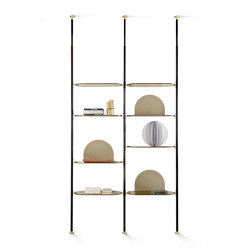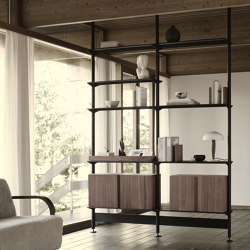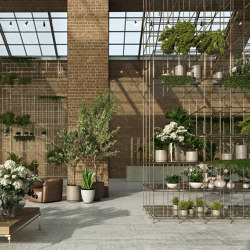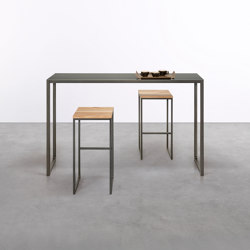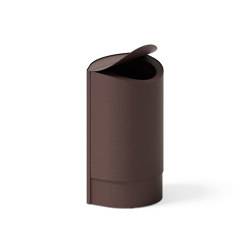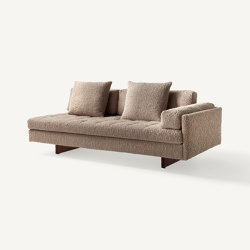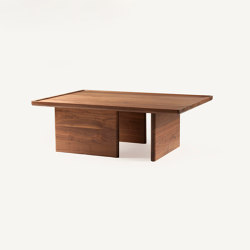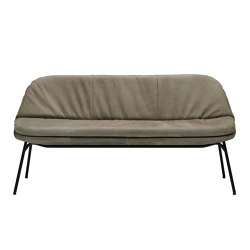À propos de BD Barcelona
EN SAVOIR PLUS SUR BD BARCELONA
Bd: a mere two letters. We are well aware of their enigmatic nature, their cryptic meaning for many. However, we are honoured and proud to note that, today, they are associated, albeit with that lingering uncertainty, with one of the very best design philosophies. What, in 1972 was an expression of almost insolent rebellion by a group of young, unsatisfied architects soon became a productive philosophy with a mission to break moulds, even commercial ones.
The Bocaccio Design (a clue for those who were not already in on the secret) of the Barcelona of the early seventies was created by Pep Bonet, Cristian Cirici, Lluís Clotet, Mireia Riera and Óscar Tusquets as a vehicle for the production of all those items of furniture, objects and accessories which could not be found in shops. It might have turned out to be nothing more than an arrogant idea, but in fact became a unique experience, offering an interpretation of design hitherto unknown in Spain: a new sensibility, a different perception of everyday objects.
We believe that this initial stimulus has become enriched over the intervening years with mixtures which, to us, appear exquisite. It is for this reason that we have published them. In this way, contemporary creations have co-existed in our catalogue with those of the great, universally admired masters, revealing our weaknesses and preferences. Siza Viera, Ettore Sottsass, Javier Mariscal, Alessanro Mendini, Miguel Milá and Pete Sans have shared space with Antoni Gaudì, Charles Rennie Mackintosh, Giuseppe Terragni, Josef Hoffman or Adolf Loos in Bd’s magnificent headquarters, the Casa Thomas (1895), a Modernista building by Domènech i Montaner which was worthy winner in 1979 of Spain’s National Restoration Award.
Bd’s history has been accompanied by other forms of recognition, not to mention our permanent indebtedness to those who have placed their trust in us. These include numerous Adi Fad Deltas de Oro, Spain’s 1989 National Design Award and the 1990 European Community Design Prize, all have which given us valued support, confirming as they do our manner of understanding and working in the field of design: for Bd does not produce –it publishes. For each object, we seek the very best process, that most suited to its essence, so that each is the result of the skill and care of genuine craftsmen or of the most advanced, intelligent technology. Select parts and select manufacturers: select works. They couldn’t be otherwise, related as they are with the most intimate of environments. Consumers, too, select those friends who they will let enter their home and who will live with them.
Time has passed, but our initial philosophy remains unshakeable, distanced in a way from today’s dizzying hurly-burly. This is what we aim to show both in our catalogue and in the extensive number of exhibitions held in our showroom, which have been intended as our contribution to promoting the culture of design. Our wish has been for our furniture and accessories to be contemplated, enjoyed and lived in a different way, that, in them, on can perceive the history of their forms (both distant and recent), their past and their future. A way of treating contemporary design which has been echoed (for which, once again, our thanks) in the permanent collections of the Philadelphia Art, Victoria and Albert and Paris Decorative Arts Museums and New York’s MOMA. In this way, our everyday work has gained exposure well beyond Spain’s frontiers.
These same criteria lie behind Bd’s future in the new millennium. We shall continue to back the idea of co-existence with furniture and objects, of using them as everyday tools, but also as an expression of a pleasing relationship with their forms, their textures and with what they evoke. To live and share life with them.
This is our hope. And our work.
Bd: a mere two letters. We are well aware of their enigmatic nature, their cryptic meaning for many. However, we are honoured and proud to note that, today, they are associated, albeit with that lingering uncertainty, with one of the very best design philosophies. What, in 1972 was an expression of almost insolent rebellion by a group of young, unsatisfied architects soon became a productive philosophy with a mission to break moulds, even commercial ones.
The Bocaccio Design (a clue for those who were not already in on the secret) of the Barcelona of the early seventies was created by Pep Bonet, Cristian Cirici, Lluís Clotet, Mireia Riera and Óscar Tusquets as a vehicle for the production of all those items of furniture, objects and accessories which could not be found in shops. It might have turned out to be nothing more than an arrogant idea, but in fact became a unique experience, offering an interpretation of design hitherto unknown in Spain: a new sensibility, a different perception of everyday objects.
We believe that this initial stimulus has become enriched over the intervening years with mixtures which, to us, appear exquisite. It is for this reason that we have published them. In this way, contemporary creations have co-existed in our catalogue with those of the great, universally admired masters, revealing our weaknesses and preferences. Siza Viera, Ettore Sottsass, Javier Mariscal, Alessanro Mendini, Miguel Milá and Pete Sans have shared space with Antoni Gaudì, Charles Rennie Mackintosh, Giuseppe Terragni, Josef Hoffman or Adolf Loos in Bd’s magnificent headquarters, the Casa Thomas (1895), a Modernista building by Domènech i Montaner which was worthy winner in 1979 of Spain’s National Restoration Award.
Bd’s history has been accompanied by other forms of recognition, not to mention our permanent indebtedness to those who have placed their trust in us. These include numerous Adi Fad Deltas de Oro, Spain’s 1989 National Design Award and the 1990 European Community Design Prize, all have which given us valued support, confirming as they do our manner of understanding and working in the field of design: for Bd does not produce –it publishes. For each object, we seek the very best process, that most suited to its essence, so that each is the result of the skill and care of genuine craftsmen or of the most advanced, intelligent technology. Select parts and select manufacturers: select works. They couldn’t be otherwise, related as they are with the most intimate of environments. Consumers, too, select those friends who they will let enter their home and who will live with them.
Time has passed, but our initial philosophy remains unshakeable, distanced in a way from today’s dizzying hurly-burly. This is what we aim to show both in our catalogue and in the extensive number of exhibitions held in our showroom, which have been intended as our contribution to promoting the culture of design. Our wish has been for our furniture and accessories to be contemplated, enjoyed and lived in a different way, that, in them, on can perceive the history of their forms (both distant and recent), their past and their future. A way of treating contemporary design which has been echoed (for which, once again, our thanks) in the permanent collections of the Philadelphia Art, Victoria and Albert and Paris Decorative Arts Museums and New York’s MOMA. In this way, our everyday work has gained exposure well beyond Spain’s frontiers.
These same criteria lie behind Bd’s future in the new millennium. We shall continue to back the idea of co-existence with furniture and objects, of using them as everyday tools, but also as an expression of a pleasing relationship with their forms, their textures and with what they evoke. To live and share life with them.
This is our hope. And our work.
EN SAVOIR PLUS SUR BD BARCELONA


